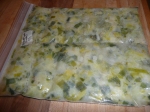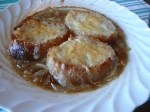Just like sautéed onions, sautéed mushrooms are pretty handy to keep in the fridge.
I used to make duxelle (sauteed chopped mushrooms with wine) because Jacques Pepin told us to keep it handy when we find cheap and imperfect mushrooms. Despite of his advice, I often couldn’t find the use for it…
Instead, I found keeping a container full of sautéed sliced mushrooms more versatile. Unlike Duxelle, which is made with chopped mushrooms, these sliced mushrooms can be used for a base for any mushroom sauce. If the recipe calls for chopped mushrooms, I can still chop them small, not the other way around.
Since most mushroom dishes call for chopped onions or shallots, I often sautee them first, then add sliced mushrooms, salt and pepper, and wine. Just like sautéed onions or mirepoix, I cook them in Extra Virgin Olive Oil rather than butter. Of course, you can cook it with butter for a richer flavor.
I found 2 lbs of perfectly fine assortment of mushrooms for only 99c at a market near our house the other day! Many stores offer similar specials on mushrooms. Take advantage of them. Slice (you can use egg slicers if you want), and sautee them for various dishes throughout the week. They keep well in freezer if you cannot finish them all after several days.
When you want to freeze something, it’s crucial to spread it relatively thin, about ¼-1/3 inch, so that it’s easier to break it off only the amount you need. I use a Ziploc Quart bag, and if the layer of mushrooms is thicker than that, I use a second one.
It’s helpful to create creases with a thin, but dull object, like a chopstick so that it’s even easier to break off what you need. I like to have a both vertical and horizontal creases for smaller amounts, especially if it’s on the thicker side.
Usage: Steaks, burgers, chicken/veal marsala, beef stroganoff, mushroom pilaf, kasha with mushrooms, warm mushroom salad, pasta, risotto, polenta, tart, quiche, crepe, white sauce with mushrooms, mushroom soup, etc. OR chop them and add in stuffings, ravioli, etc.
Tips: Sautéing mushrooms often requires a lot of oil or butter. If you want to cut fat, add salt to mushrooms immediately after you start sautéing. It will draw out the moisture and requires a lot less oil.
Since we’ve talked about both sauteed onions and mushrooms, it’s time to talk about my favorite, Magic Mushroom Soup tomorrow…







